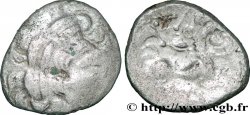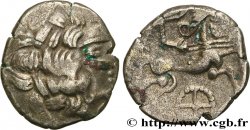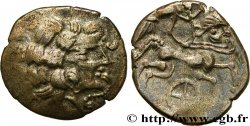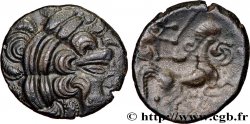bga_270845 - REDONES (Area of Rennes) Statère d’or à la cavalière armée et à la lyre - fourré et coupé en deux
недоступный.
Товар уже продан в нашем интернет-магазине (2016)
Цена: : 180.00 €
Товар уже продан в нашем интернет-магазине (2016)
Цена: : 180.00 €
Тип Statère d’or à la cavalière armée et à la lyre - fourré et coupé en deux
Дата: c. 200-150 AC.
Металл: electrum
Диаметр: 15 mm
Вес: 3,73 g.
Редкость: R3
Комментарии о состоянии
Monnaie avec une découpe assez nette, fortement enganguée d’une matière sombre et lisse. Avers et revers incomplets mais identifiable malgré une frappe un peu molle
Лицевая сторона
Аверс: легенда: ANÉPIGRAPHE.
Аверс: описание: Restes de tête laurée à droite.
Обратная сторона
Реверс: легенда: ANÉPIGRAPHE.
Реверс: Описание: Cavalière à droite, brandissant un bouclier et une épée ; entre les jambes du cheval, une lyre accostée d’une croisette bouletée.
Комментарий
Ce statère semble pouvoir être rapproché du statère à la cavalière armée et à la lyre. Il semble être fourré, l’âme du métal étant particulièrement visible au niveau du coup de burin, à moins que le métal des dernières séries soit fortement allié de cuivre.
Si le phénomène de couper des monnaies en deux pour en faire des divisionnaires est bien attesté pour les monnaies de bronzes (as de Nîmes) et pour les potins, il nous semble que ce soit beaucoup plus rare pour les statères.
Comme pour le bga_270844, l'inexistence d’hémi-statère ou leur extrême rareté a pu motiver la découpe de cette monnaie. A moins qu’il s’agisse d’une démonétisation ou encore d’un morceau de métal destiné à la refonte....
Si le phénomène de couper des monnaies en deux pour en faire des divisionnaires est bien attesté pour les monnaies de bronzes (as de Nîmes) et pour les potins, il nous semble que ce soit beaucoup plus rare pour les statères.
Comme pour le bga_270844, l'inexistence d’hémi-statère ou leur extrême rareté a pu motiver la découpe de cette monnaie. A moins qu’il s’agisse d’une démonétisation ou encore d’un morceau de métal destiné à la refonte....








 Cообщить об ошибке
Cообщить об ошибке Распечатать страницу
Распечатать страницу Отправить мой выбор
Отправить мой выбор Задать вопрос
Задать вопрос Consign / sell
Consign / sell
 Информация
Информация



